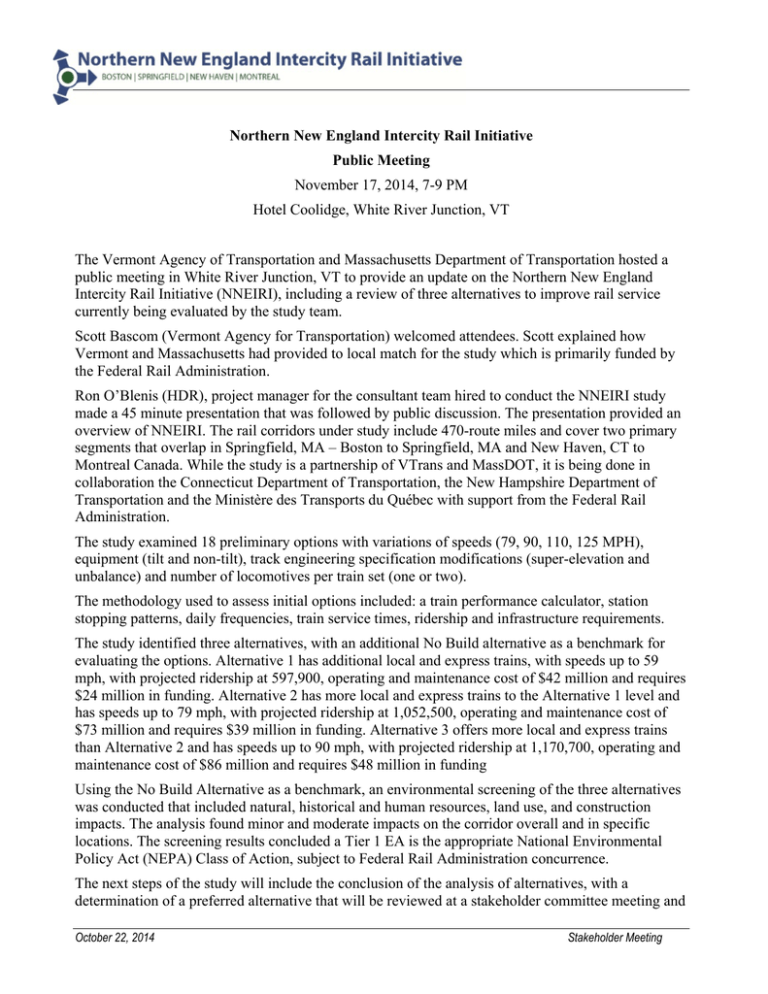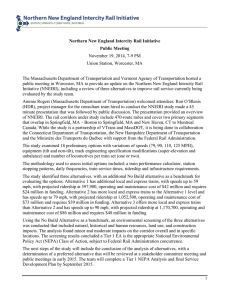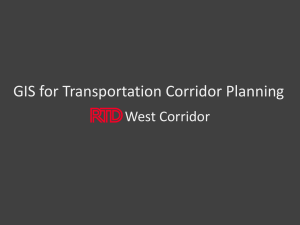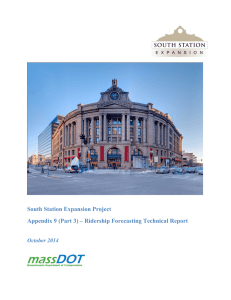Northern New England Intercity Rail Initiative Public Meeting
advertisement

Northern New England Intercity Rail Initiative Public Meeting November 17, 2014, 7-9 PM Hotel Coolidge, White River Junction, VT The Vermont Agency of Transportation and Massachusetts Department of Transportation hosted a public meeting in White River Junction, VT to provide an update on the Northern New England Intercity Rail Initiative (NNEIRI), including a review of three alternatives to improve rail service currently being evaluated by the study team. Scott Bascom (Vermont Agency for Transportation) welcomed attendees. Scott explained how Vermont and Massachusetts had provided to local match for the study which is primarily funded by the Federal Rail Administration. Ron O’Blenis (HDR), project manager for the consultant team hired to conduct the NNEIRI study made a 45 minute presentation that was followed by public discussion. The presentation provided an overview of NNEIRI. The rail corridors under study include 470-route miles and cover two primary segments that overlap in Springfield, MA – Boston to Springfield, MA and New Haven, CT to Montreal Canada. While the study is a partnership of VTrans and MassDOT, it is being done in collaboration the Connecticut Department of Transportation, the New Hampshire Department of Transportation and the Ministère des Transports du Québec with support from the Federal Rail Administration. The study examined 18 preliminary options with variations of speeds (79, 90, 110, 125 MPH), equipment (tilt and non-tilt), track engineering specification modifications (super-elevation and unbalance) and number of locomotives per train set (one or two). The methodology used to assess initial options included: a train performance calculator, station stopping patterns, daily frequencies, train service times, ridership and infrastructure requirements. The study identified three alternatives, with an additional No Build alternative as a benchmark for evaluating the options. Alternative 1 has additional local and express trains, with speeds up to 59 mph, with projected ridership at 597,900, operating and maintenance cost of $42 million and requires $24 million in funding. Alternative 2 has more local and express trains to the Alternative 1 level and has speeds up to 79 mph, with projected ridership at 1,052,500, operating and maintenance cost of $73 million and requires $39 million in funding. Alternative 3 offers more local and express trains than Alternative 2 and has speeds up to 90 mph, with projected ridership at 1,170,700, operating and maintenance cost of $86 million and requires $48 million in funding Using the No Build Alternative as a benchmark, an environmental screening of the three alternatives was conducted that included natural, historical and human resources, land use, and construction impacts. The analysis found minor and moderate impacts on the corridor overall and in specific locations. The screening results concluded a Tier 1 EA is the appropriate National Environmental Policy Act (NEPA) Class of Action, subject to Federal Rail Administration concurrence. The next steps of the study will include the conclusion of the analysis of alternatives, with a determination of a preferred alternative that will be reviewed at a stakeholder committee meeting and October 22, 2014 Stakeholder Meeting public meetings in early 2015. The team will complete a Tier 1 NEPA Analysis and final Service Development Plan by September 2015. Questions and Comments Following the presentation, attendees asked several questions and offered comments (see italics). Responses to the questions were made primarily by Ron O’Blenis and John Weston of the study team. Bus service & airport connections Do you know how many people are riding the buses today? We do not have the numbers tonight but intercity bus service was used as a factor in the creation of the study’s ridership model. Intercity bus should be included in this study and how it can be built to provide passenger rail with good connectivity. An important aspect of the next phases of this study is how this service impacts towns and station areas and what can be done to leverage this new infrastructure. We are going to take a look at investments and lessons learned from places around the nation to show what has been done elsewhere, including bus connections and economic development. It’s not a single approach that works, but there are many different ideas that are successfully used in individual cities and towns. You should show the existing intercity bus connections now. Show how these can tie into what is being proposed. We will look at examples from around the country and will provide a guidebook on how to leverage investment to show connections. A good example is Amtrak’s Downeaster and services in other parts of the nation where bus and train tickets are interchangeable. This is a long-term project; we are planning for 15-20 years in the future while bus services can change at any time. In this corridor, we are excited about the rebuilding of the train station in Springfield, MA as it will become an intermodal center when connections can be more easily made. Would there be any attempt to connect NNEIRI service to airports? I fly all the time to the Midwest and frankly there isn’t a good way of getting to a major airport without driving. This study is not focused on people coming into airports. The majority of riders will be using this service to get around New England and New York. As far as the busses and local infrastructure to connect to the rails – once the improvement is done, the infrastructure will follow. Around Vermont there’s a consciousness of transportation and how it works. Also, I believe Greyhound is not a great form of transportation and I would prefer a train to a bus. October 22, 2014 Stakeholder Meeting Costs The train costs, $22 million per set, seem astronomical. I believe actual numbers are lower. We’re not getting good deal. Let’s buy used equipment from China. Could you please clarify the origin of these numbers? Equipment is not cheap. A new locomotive costs about $5 million. Even refurbished cars cost $2.5-3 million each. Therefore, for a six car trainset with a locomotive, these numbers are appropriate. We also factored in a contingency into these numbers. Who would be buying the cars? This study is not determining an operator at this point. There is an ongoing national discussion about the future of Amtrak. Could a large contract drive down the costs of these trains? The numbers are based on train sets that are being procured around the nation. They represent costs for recent purchases of train equipment from around the country. These operating costs get progressively more expensive. Is there any attempt to split how these are going to be allocated between states? That will be the next step. We eventually need to have a policy type discussion. We are not seeking to create an expectation before we complete the analysis and create unrealistic expectations. Was the Vermonter factored into these costs? No, the Vermonter was above that cost. Would the federal government be kicking in some funding for this project? The expectation is the federal government might provide some capital funding. There are numerous examples around New England of this already occurring. It’s a balance between what is available on the federal level and funding needs across the nation. Regarding train sets, we see numerous examples of where transit authorities used old trains to save costs, MARC in Maryland for example. Also, people are less time sensitive on trains than in cars because they can use a lap top and have a more comfortable ride than a car or bus; therefore, does the cost of the infrastructure need to be so high? Do we really need very high speed trains? We could certainly use restored equipment, but what we are looking at here is a project that could be 25 years out. Therefore, it is important to understand the full capital costs and implications of this service. We are not creating new right of way because this corridor will enable us to utilize an existing and in-use right of way. These costs are so high because we want reliability. A significant amount of the costs here represent state of good repair projects and federally required signaling. Was there any consideration given to sharing costs with freight? Do these costs include paying freight operating companies to use their right of way? Is there a cost associated here? The assumptions assume that we will be using the freight right of way. We anticipate that future negotiations with freight operators will produce more concrete figures. October 22, 2014 Stakeholder Meeting Claremont, NH We are very appreciative of all the efforts of the consulting team. Now that you’ve included Claremont on the station list and taken our thoughts into account, we are happy with the work done. I am a Claremont citizen, on the Amtrak committee, and a member of the city council. Claremont Station has a huge population surrounding it. We appreciate your analysis and inclusion of Claremont as a station for the service. Study assumptions and presentation No-build statistics should be better represented here and presented in the same manner as the other alternatives. We need to know what is the current operating situation and this should be presented clearly and effectively. There needs to be analysis of the benefits of this project to a greater degree. Also the environmental analysis is conservative. The reality is that carbon is extremely important going forward. It’s a matter of decades before carbon is regulated. There is a measurable sizable tonnage of carbon that will be saved. The study will be looking at other impacts than were presented tonight. Future analysis will include issues surrounding air quality and secondary impacts such as economic development. The Tier 1 analysis will look at positive impacts, not just avoiding negative impacts. We need to take into account the logic of bringing high speed rail from the NEC to the Upper Valley of Vermont. The question is, do we really want to be just three hours from New York? Do we want to be the next Westchester County? Does this study include the resumption of service to Montreal? Does this include a station in Downtown Montreal? Vermont’s Congressional delegation has been working closely with Canada and U.S. Immigration and Customs Enforcement (ICE) to get a sealed station in Montreal, with no station stops from the border to Montreal. There’s a tremendous amount of work that’s being done. It will take an international treaty and an act of Congress to approve the facility. We expect to have a customs clearing unit with Central Station, Montreal up and running in three years. It’s moving forward and it’s a goal of the Vermont governor and that State of Vermont to resume service to Montreal. There are two assumptions that worry me in the long run. The mythical business traveler will not take this service from Boston to Montreal. They will drive. Also, Wifi is critical. We should build something cheap and go from there. Our ridership analysis shows that there is relatively little ridership from Boston to Montreal. Most of the ridership is getting around New England rather than between these two cities, point to point. The model is calibrated to Amtrak service around the nation. This is not the same business traveler as the 1950s version. The model looks travelers across the Northeast to determine the ridership profile. This study is a vision of what could be done around New England. Next we’re creating a service development plan. In the plan we will identify lots of little incremental steps of how we can get to that vision. The great thing about developing rail in this way is that it can be done bit by bit by bit rather than as a gigantic project. October 22, 2014 Stakeholder Meeting The alternatives presented seem more like phases rather than true alternatives. Could you please explain how these are different than phases? We are looking into different alternatives and what they would generate for costs and ridership. These alternatives are distinct because they present different long-term visions for the Corridor, with different frequencies. We do not need high speed. We just need more trains. All that we need is simple trains with WiFi. If you provide more service, the ridership will increase. Train is preferred way even though it takes a bit longer. Safety Safety has not been mentioned once in this presentation. Massachusetts has a very strong rail trespassing law. There’s no law enforcement in Vermont to send out to look at these people. Hartford is only community in Vermont that enforces trespassing. The more trains you have, the more the issue. How will Vermont address this? There’s an effort within these projects to respond to safety. At grade crossings that are private infrastructure, such as farm crossings, is there a plan or concept of what might be done on farm road type crossings? Securing the crossings with gates that are locked is important. There could be some policing of that to make sure it’s done. We are looking at providing gates, where the farmer has the key to the gate to be able to unlock it as needed. Sometimes if a private crossing has a lot of use, we can put public funds into it. We are not taking a one-size fits all to addressing this concern. If we are going to have high speed rail, then we are going to need to have more public education. October 22, 2014 Stakeholder Meeting




